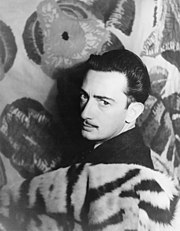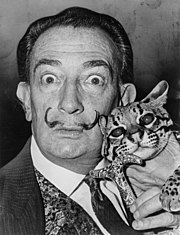
A Surreal Journey, originalmente cargada por Pensiero.
Salvador Domingo Felipe Jacinto Dalí i Domènech, 1st Marquis of Púbol (May 11, 1904 – January 23, 1989), was a Spanish Catalan surrealist painter born in Figueres, Catalonia, Spain. Dalí was a skilled draftsman, best known for the striking and bizarre images in his surrealist work. His painterly skills are often attributed to the influence of Renaissance masters. His best known work, The Persistence of Memory, was completed in 1931. Salvador Dalí's artistic repertoire also included film, sculpture, and photography. He collaborated with Walt Disney on the unfinished Academy Award-nominated short cartoon Destino, which was completed and released posthumously in 2003. He also collaborated with Alfred Hitchcock on the dream sequence from his 1945 film Spellbound.
Dalí insisted on his "Arab lineage", claiming that his ancestors were descended from the Moors who occupied Southern Spain for nearly 800 years (711-1492), and attributed to these origins, "my love of everything that is gilded and excessive, my passion for luxury and my love of oriental clothes."
Widely considered to be greatly imaginative, Dalí had an affinity for doing unusual things to draw attention to himself. This sometimes irked those who loved his art as much as it annoyed his critics, since his eccentric manner sometimes drew more public attention than his artwork. The purposefully-sought notoriety led to broad public recognition and many purchases of his works by people from all walks of life.
| Salvador Dalí, Marquis de Púbol | |
 Salvador Dalí Photo by Carl Van Vechten taken 29 November 1939 | |
| Birth name | Salvador Domingo Felipe Jacinto Dalí i Domènech |
| Born | May 11, 1904 Figueres, Catalonia, Spain |
| Died | January 23, 1989 (aged 84) Figueres, Catalonia, Spain |
| Nationality | Spanish |
| Field | Painting, Drawing, Photography, Sculpture, Writing |
| Training | San Fernando School of Fine Arts, Madrid |
| Movement | Cubism, Dada, Surrealism |
| Works | The Persistence of Memory (1931) Face of Mae West Which May Be Used as an Apartment, (1935) Soft Construction with Boiled Beans (Premonition of Civil War) (1936) Swans Reflecting Elephants (1937) Ballerina in a Death's Head (1939) The Temptation of St. Anthony (1946) Galatea of the Spheres (1952) Young Virgin Auto-Sodomized by the Horns of Her Own Chastity (1954) |
The elephant is also a recurring image in Dalí's works. It first appeared in his 1944 work Dream Caused by the Flight of a Bee around a Pomegranate a Second Before Awakening. The elephants, inspired by Gian Lorenzo Bernini's sculpture base in Rome of an elephant carrying an ancient obelisk, are portrayed "with long, multi-jointed, almost invisible legs of desire" along with obelisks on their backs. Coupled with the image of their brittle legs, these encumbrances, noted for their phallic overtones, create a sense of phantom reality. "The elephant is a distortion in space", one analysis explains, "its spindly legs contrasting the idea of weightlessness with structure." … I am painting pictures which make me die for joy, I am creating with an absolute naturalness, without the slightest aesthetic concern, I am making things that inspire me with a profound emotion and I am trying to paint them honestly. —Salvador Dalí, in Dawn Ades, Dalí and Surrealism.
 Making antics in the 1960s
Making antics in the 1960sDalí was a versatile artist, not limiting himself only to painting in his artistic endeavors. Some of his more popular artistic works are sculptures and other objects, and he is also noted for his contributions to theatre, fashion, and photography, among other areas.
Dalí produced over 1,500 paintings in his career, in addition to producing illustrations for books, lithographs, designs for theater sets and costumes, a great number of drawings, dozens of sculptures, and various other projects, including an animated cartoon for Disney. He also collaborated with director Jack Bond in 1965, creating a movie titled "Dali in New York." Below is a chronological sample of important and representative work, as well as some notes on what Dalí did in particular years:
In his youth, Dalí embraced for a time both anarchism and communism. His writings account various anecdotes of making radical political statements more to shock listeners than from any deep conviction, which was in keeping with Dalí's allegiance to the Dada movement. As he grew older his political allegiances changed, especially as the Surrealist movement went through transformations under the leadership of the Trotskyist André Breton who is said to have called Dalí in for questioning on his politics. In his 1970 book Dalí by Dalí, Dalí was declaring himself an anarchist and monarchist giving rise to speculations of Anarcho-Monarchism.
http://en.wikipedia.org/wiki/Salvador_Dal%C3%AD













No hay comentarios:
Publicar un comentario